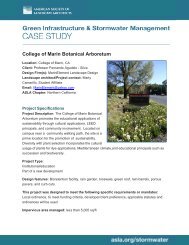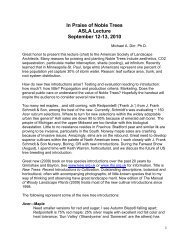(R)evolution: - American Society of Landscape Architects
(R)evolution: - American Society of Landscape Architects
(R)evolution: - American Society of Landscape Architects
Create successful ePaper yourself
Turn your PDF publications into a flip-book with our unique Google optimized e-Paper software.
[MON-B09 ]<br />
(R)<strong>evolution</strong>:<br />
Planning for Ecological Change and Resiliency at a<br />
Public Garden
DESCRIPTION<br />
In the face <strong>of</strong> increased environmental pressures, landscape architects and clients<br />
have the ability to influence our environment’s capacity for resiliency and provide<br />
ecosystem services. By examining conservation ethics and the planning process <strong>of</strong><br />
a public garden, this session explores transformative endeavors which strive to unite<br />
conservation, horticulture and education.<br />
LEARNING OBJECTIVES<br />
• Understand the role landscape architects and clients can play in the ecological<br />
health and resiliency <strong>of</strong> our ecoregions<br />
• Explore the ethical considerations <strong>of</strong> landscape architecture interventions at the<br />
interface <strong>of</strong> conservation biology and increased urbanization, including global<br />
climate change and the northern migration <strong>of</strong> plants<br />
• Review best practices for ecoregion-specific master planning and to understand<br />
the adaptive capacity <strong>of</strong> a site<br />
• Discover the importance <strong>of</strong> the human dimension <strong>of</strong> ecological restoration and<br />
conservation and how to foster positive relationships between people and their<br />
environment<br />
• Explore the possibilities <strong>of</strong> integrating sustainability standards in a public garden’s<br />
operations and maintenance strategies<br />
to conserve and promote the region’s native<br />
plants to ensure healthy, biologically diverse<br />
landscapes.
PRESENTATION OUTLINE<br />
I. The History and Mission <strong>of</strong> New England Wild Flower <strong>Society</strong><br />
A. History <strong>of</strong> the institution—the nation’s oldest plant conservation organization, working in all six New<br />
England states<br />
B. History <strong>of</strong> the site, Garden in the Woods-- Started by landscape architect Will Curtis in 1931 as his<br />
personal garden showcasing native plants in naturalistic displays on a stunning site<br />
C. Mission statement—“ to conserve and promote the region’s native plants to ensure healthy,<br />
biologically diverse landscapes”—and the vision for the Garden<br />
II. Project Background: The role <strong>of</strong> Garden in the Woods as an educational<br />
canvas and embodiment <strong>of</strong> a conservation mission in planning for the future<br />
A. Identify the financial, social, operational and conservation challenges associated with a wellestablished<br />
public garden who is facing an aging infrastructure, ecological degradation and climatedriven<br />
uncertainty<br />
B. Discuss how the Garden plans to meet those challenges and the meaning <strong>of</strong> resiliency—<br />
ecological, financial and operational<br />
C. Present the quest for a philosophical and physical master plan that addresses the conservation and<br />
operational challenges <strong>of</strong> the site and ecoregion and that bridges the divide between conservation<br />
and horticulture<br />
III. The Ingredients <strong>of</strong> a Master Plan in an Age <strong>of</strong> Uncertainty<br />
A. Guiding Principles—“with position in the landscape comes responsibility”<br />
B. Conceptual strategies for managing resilience and the unique position <strong>of</strong> the <strong>Society</strong> (“A regional<br />
conservation organization that happens to own a botanic garden”)<br />
C. Embedding resiliency and maintaining integrity—the master plan<br />
IV. A Call for Action: Challenges for the future <strong>of</strong> public gardens, conservation<br />
organizations and landscape architecture<br />
A. Public gardens’ role as “modern-day arks”<br />
B. The role <strong>of</strong> native plants in urban, suburban and rural contexts—it’s all about health, safety and<br />
welfare<br />
C. Ecoregion-specific analysis and planning tools<br />
D. Demanding appropriate plant ecotypes, especially in restoration projects<br />
E. The ethics <strong>of</strong> assisted migration <strong>of</strong> plant ecotypes<br />
Wet Meadow<br />
Pitch Pine<br />
Barren<br />
Hop Brook<br />
Pine Hill<br />
White Pine -<br />
Oak Forest<br />
Beech Grove<br />
Transitional<br />
Terrace<br />
Transitional<br />
Slopes<br />
Trial Garden<br />
The Cove<br />
Kettle Hole<br />
Bog<br />
Lady’s-Slipper<br />
Woods<br />
Lost Pond<br />
Laurel<br />
Bend<br />
Dry Oak<br />
Forest<br />
Successional Swamp<br />
Plateau Garden<br />
Curtis Woodland Garden<br />
Lily Pond + Atlantic White Cedar Bog<br />
$<br />
0<br />
0 105<br />
2
PRESENTERS<br />
Debbi Edelstein<br />
Executive Director, New England Wild Flower <strong>Society</strong><br />
Debbi Edelstein is the Executive Director <strong>of</strong> New England Wild Flower <strong>Society</strong>, the nation’s oldest<br />
plant conservation organization. She led the goal-setting process for the master plan for Garden<br />
in the Woods and chairs the planning committee. Previously, she served as a Vice President <strong>of</strong><br />
National Audubon <strong>Society</strong> and Executive Director <strong>of</strong> Audubon Washington; was a senior manager at<br />
the Northeast’s regional air quality association; led the nonpr<strong>of</strong>it partner’s role in creating a 14,000-<br />
acre bioreserve in southeastern Massachusetts; and served as Executive Director <strong>of</strong> a watershed<br />
association. She holds a master’s degree in environmental policy and planning from MIT.<br />
Mark Richardson<br />
Director <strong>of</strong> Horticulture, New England Wild Flower <strong>Society</strong><br />
Mark Richardson is Director <strong>of</strong> Horticulture for the New England Wild Flower <strong>Society</strong>, where he<br />
oversees the <strong>Society</strong>’s botanical garden, Garden in the Woods, and its native plant nursery operation,<br />
Nasami Farm. He studied ornamental horticulture at University <strong>of</strong> Rhode Island while helping to<br />
run a mid-size ornamental plant nursery before finding his true passion in public horticulture. Mr.<br />
Richardson led undergraduate programs at Longwood Gardens, where he directed a curriculum<br />
overhaul <strong>of</strong> the Pr<strong>of</strong>essional Gardener Program, and adult education at Brookside Gardens. He holds<br />
a master’s degree from the University <strong>of</strong> Delaware’s Longwood Graduate Program.<br />
José Almiñana, FASLA, LEED AP<br />
Principal, Andropogon Associates<br />
José Almiñana is a principal at Andropogon Associates and has over 30 years <strong>of</strong> experience with the<br />
firm. Trained as both a landscape architect and architect, his collaborative work strives to achieve<br />
the highest possible performance with the least amount <strong>of</strong> resources. For SITES, he has served<br />
as a member <strong>of</strong> the Steering Committee and now serves on the Technical Core Committee for the<br />
Pilot Project Phase. José is a visiting lecturer at the University <strong>of</strong> Pennsylvania School Of Design,<br />
Drexel University and Philadelphia University. José currently serves on the City <strong>of</strong> Philadelphia Art<br />
Commission.<br />
Emily McCoy, RLA, ASLA<br />
Director <strong>of</strong> Integrative Research, Andropogon Associates<br />
Emily McCoy, RLA, ASLA is the Director <strong>of</strong> Integrative Research at Andropogon Associates and<br />
an adjunct pr<strong>of</strong>essor in Temple University’s MLA program, which focuses on ecological landscape<br />
restoration. In both roles, Ms. McCoy strives to contribute to the knowledge base <strong>of</strong> landscape<br />
architecture by exploring the interplay between pr<strong>of</strong>essional practice and scholarship. Emily’s recent<br />
projects include Panther Hollow Watershed Restoration, Garden-in-the-Woods Master Plan, USCG<br />
Headquarters and UPenn Shoemaker Green. Emily holds an MLA with a concentration in natural<br />
resource management from NCSU; an B.S. in Ecology from Appalachian State University; and has<br />
valuable pr<strong>of</strong>essional experience as a horticulturist and researcher.
new england WILD<br />
news and insights on conserving native plants & their habitats • summer 2013<br />
The Ever-Changing<br />
<strong>Landscape</strong>
horticulture<br />
Past is Prologue:<br />
The Evolution <strong>of</strong> a Garden<br />
The Gardener as Artist<br />
Will Curtis and his partner Dick Stiles<br />
imbued Garden in the Woods with their<br />
spirit <strong>of</strong> experimentation, instinct for naturalistic<br />
garden design, and a sense <strong>of</strong> wonder<br />
that is clear some 82 years after the first<br />
shovel hit the earth. Curtis was an artist<br />
who, according to Stiles, never worked from<br />
a plan, “for it was all in that brain that could<br />
envision and feel and know just how it should<br />
be.” Although they <strong>of</strong>ten appear effortless,<br />
naturalistic gardens are the most challenging<br />
to envision and among the most challenging<br />
to maintain. How can one improve or<br />
perfect that which took eons for nature to<br />
create? How does one choose which trees<br />
to fell in a forest to create the perfect<br />
amount <strong>of</strong> dappled light for a garden <strong>of</strong><br />
spring ephemerals? Where is the best place<br />
to site a path to make it seem like a naturally<br />
occurring feature <strong>of</strong> a garden? Curtis’s<br />
mastery <strong>of</strong> this art form, developed over a<br />
lifetime <strong>of</strong> gardening, is apparent throughout<br />
Garden in the Woods.<br />
For longtime members <strong>of</strong> the<br />
<strong>Society</strong>, the history <strong>of</strong> Garden in the Woods<br />
is familiar. But what we don’t <strong>of</strong>ten consider<br />
is that Curtis, like most gardeners, never<br />
truly “finished” his garden but simply ran<br />
out <strong>of</strong> time to undertake whatever next<br />
steps he envisioned. Given more active<br />
years, he may have built more habitat garden<br />
displays, expanded into the “natural<br />
areas” serving as buffers, or even torn out<br />
and replanted entire garden sections. No<br />
one can say how Curtis’s garden might have<br />
evolved, but when I consider his passion, I<br />
realize that I have never visited a “finished”<br />
garden, private or public, because by their<br />
very nature, gardens are dynamic and constantly<br />
evolving. They change from season<br />
to season, month to month, and <strong>of</strong>ten hour<br />
New England WILD • Summer 2013<br />
2<br />
www.newenglandwild.org
Curtis cabin and pit greenhouse, circa 1937.<br />
Dick Stiles and Will Curtis at Garden in the Woods.<br />
to hour; they change by design and by natural<br />
intervention.<br />
As an artist whose medium was<br />
plants, Curtis was aware <strong>of</strong> the fragility <strong>of</strong><br />
his creations and, like all gardeners,<br />
embraced—eagerly or reluctantly—the<br />
inevitability <strong>of</strong> change. The devastation<br />
wrought by the 1938 hurricane nearly convinced<br />
him to abandon his dream. Garden<br />
in the Woods lost nearly three hundred<br />
large trees. That kind <strong>of</strong> devastation is not<br />
unlike the loss <strong>of</strong> the one perfect tree over<br />
a small shade garden in a residential neighborhood.<br />
The effect is the same on the gardener–shock,<br />
sadness, and dismay at the<br />
prospect <strong>of</strong> losing a lifetime <strong>of</strong> work, followed<br />
by excitement at the possibility <strong>of</strong><br />
renewal in newfound sunlight. Curtis knew<br />
that his garden was just as vulnerable to the<br />
next storm, to late frosts, pests, or diseases.<br />
But he devoted half a lifetime to creating a<br />
“big wild garden” anyway. Despite the<br />
threats, gardeners soldier on, intent on satisfying<br />
their own artistic interests and creating<br />
something beyond themselves, something<br />
beautiful to share with others. The<br />
vision for the garden adapts to change out<br />
<strong>of</strong> necessity, and the garden benefits from<br />
the dynamism <strong>of</strong> creative thought.<br />
The Path to Garden in the Woods<br />
Born in Schuylerville, New York, in 1883,<br />
Will Curtis was a plant lover from an early<br />
age—he planted his first garden when he<br />
was nine. While working for a florist as a<br />
teenager, he began dreaming <strong>of</strong> one day<br />
having a big wildflower garden. His passion<br />
led him to earn a degree in landscape architecture<br />
from Cornell University and eventually<br />
to working as <strong>of</strong>fice manager for<br />
landscape architect Warren H. Manning, an<br />
early pioneer <strong>of</strong> the “wild garden” movement<br />
and a founding member <strong>of</strong> the<br />
<strong>American</strong> <strong>Society</strong> <strong>of</strong> <strong>Landscape</strong> <strong>Architects</strong>.<br />
Manning apprenticed with Frederick Law<br />
Olmsted, considered by many to be the<br />
father <strong>of</strong> <strong>American</strong> landscape architecture,<br />
before beginning his own design firm in<br />
Billerica, Massachusetts, in the 1890s. His<br />
influence on Curtis’s naturalistic gardening<br />
ethos is clear: Manning advocated for “a<br />
new type <strong>of</strong> gardening wherein the<br />
<strong>Landscape</strong>r recognizes, first, the beauty <strong>of</strong><br />
existing conditions and develops this beauty<br />
to the minutest detail.” Manning’s call for<br />
an <strong>American</strong> style <strong>of</strong> landscape design that<br />
enhanced and preserved the subtle beauty<br />
<strong>of</strong> nature is expressed in the way Curtis<br />
developed Garden in the Woods to take<br />
advantage <strong>of</strong>, rather than compete with, the<br />
natural features and topography <strong>of</strong> the site.<br />
In 1931 Curtis stumbled upon a tract<br />
<strong>of</strong> land in Framingham that had “eskers<br />
with steep-sided valleys between, a pond, a<br />
wooden-bog, numerous springs, and an<br />
ever-flowing brook.” He described it as “a<br />
naturally beautiful place with interesting<br />
contours, many old trees, and a variety <strong>of</strong><br />
typical New England vegetation” that was<br />
“just the spot for a wild flower garden.” The<br />
Old Colony Railroad, which had mined<br />
part <strong>of</strong> the land for its glacial gravel<br />
deposits, sold Curtis 30 acres for $1,000, and<br />
he began developing the gardens in earnest.<br />
By this time, Curtis was manager <strong>of</strong> Little<br />
Tree Farm in Framingham and was running<br />
a fairly successful landscape design and<br />
installation business. Garden in the Woods<br />
would become a living showcase <strong>of</strong> his<br />
capabilities, a more permanent exhibition<br />
than the award-winning flower show<br />
exhibits he designed and constructed to<br />
promote his pr<strong>of</strong>essional services.<br />
By 1933 construction <strong>of</strong> the garden<br />
was well underway, and the 50-year-old<br />
Curtis recruited 23-year-old Dick Stiles to<br />
help with the heavy lifting. Stiles was not a<br />
3
Past is Prologue:<br />
The Ever-Changing Garden<br />
horticulturist by training, but proved such a<br />
quick study that Curtis invited him to<br />
become a full partner in the garden in 1936.<br />
The pair spent the next 30 years developing<br />
a garden collection <strong>of</strong> North <strong>American</strong><br />
native plants, a novel concept during that<br />
era. Among their creations, the First Garden<br />
(what we now call the Woodland Garden) is<br />
rich with spring ephemerals, woodland<br />
perennials, and flowering shrubs set beneath<br />
a high canopy <strong>of</strong> oaks. Here they used<br />
plants to create an almost rhythmic experience<br />
<strong>of</strong> light and shadow and an impressive<br />
spring display. They built the Lily Pond in<br />
1935, using mules to dredge a shallow pond<br />
and make it habitable for a variety <strong>of</strong> aquatic<br />
plants. They created habitat gardens<br />
named for their inspiration and showcasing<br />
Curtis’s wide-ranging interests as a collector<br />
and propagator <strong>of</strong> plants: he developed an<br />
alpine garden he called Mt. Washington, a<br />
pine barren he called New Jersey, and a collection<br />
<strong>of</strong> western plants he called<br />
Montana.<br />
By the mid-1960s, Curtis and Stiles<br />
had begun thinking about the future <strong>of</strong><br />
their garden. Concerned about the<br />
encroaching suburban development, they<br />
realized the only way to prevent bulldozers<br />
from destroying their lifetime <strong>of</strong> work was<br />
to find a partner to whom they could<br />
entrust its care. Curtis shared his concern<br />
with his client and friend, Homer C. Lucas,<br />
an active member and fierce advocate for<br />
the New England Wild Flower Preservation<br />
<strong>Society</strong>. Lucas helped negotiate the transfer<br />
<strong>of</strong> ownership to the <strong>Society</strong>, with an agreement<br />
that required the <strong>Society</strong> to raise an<br />
endowment to support ongoing care and<br />
maintenance <strong>of</strong> the garden. On Curtis’s<br />
82nd birthday, May 8, 1965, Curtis and<br />
Stiles gave Garden in the Woods to the<br />
<strong>Society</strong>. The two remained on staff—Curtis<br />
as Garden Director until his death in 1969,<br />
and Stiles as Curator until his retirement in<br />
1970. (He passed away in 1984.) The<br />
<strong>Society</strong> moved its headquarters from downtown<br />
Boston to the site in 1968.<br />
Above: Stiles and Curtis in the greenhouse at Garden in the Woods.<br />
Below: Stiles and Curtis giving Garden in the Woods to the New<br />
England Wild Flower Preservation <strong>Society</strong> on May 8, 1965.<br />
New England WILD • Summer 2013<br />
4<br />
www.newenglandwild.org
Thriving as Time Goes On<br />
Since 1965 New England Wild Flower<br />
<strong>Society</strong> has continued to care for Garden in<br />
the Woods as a sanctuary for both plants and<br />
people. The hand <strong>of</strong> a single man with a<br />
vision became many hands shaping the<br />
Garden’s development. New challenges, like<br />
expanding parking for visitors and adding<br />
buildings to accommodate a growing staff,<br />
have required a multitude <strong>of</strong> changes.<br />
Through them all, the <strong>Society</strong> has clearly<br />
maintained Curtis’s rustic, naturalistic<br />
design and his emphasis on experimenting<br />
with “why wild flowers will grow here and<br />
not there.” Garden in the Woods is both a<br />
collector’s paradise, with more than 1,000<br />
taxa <strong>of</strong> primarily New England native flora,<br />
and a casual visitor’s delight, especially in<br />
spring, when thousands <strong>of</strong> blooms burst<br />
forth in the warmth <strong>of</strong> April and May.<br />
As the organization’s mission has<br />
evolved, so has the Garden. In 2010 the<br />
<strong>Society</strong> renewed its focus on New England<br />
native plants with a new mission statement—“to<br />
conserve and promote the<br />
region’s native plants to ensure healthy, biologically<br />
diverse landscapes”—and a strategic<br />
plan that calls for a broader and more<br />
engaged constituency for native plants. One<br />
<strong>of</strong> the steps in building that constituency is<br />
the development <strong>of</strong> a comprehensive master<br />
plan for Garden in the Woods. In 2012 we<br />
were fortunate to secure funding from the<br />
Institute <strong>of</strong> Museum and Library Services<br />
and the Hope Goddard Iselin Foundation<br />
to pursue that effort. The plan, scheduled<br />
for completion in October <strong>of</strong> this year, will<br />
serve as the overarching vision for the<br />
Garden for the next 25 years and beyond. It<br />
will help unify the organization’s conservation<br />
and horticulture messages, honor<br />
Curtis’s legacy, and build a roadmap for a<br />
resilient garden that can adapt to the effects<br />
<strong>of</strong> climate change.<br />
The <strong>Society</strong>’s hope is that the master<br />
plan will launch a renaissance <strong>of</strong> Garden in<br />
the Woods that blends Curtis’s original<br />
vision for the garden as “a peaceful picture<br />
<strong>of</strong> our land as nature intended it” with<br />
modern sustainable design. The planning<br />
process, led by landscape architecture firm<br />
Andropogon Associates, whose guiding<br />
5<br />
principle is “designing with nature,” reflects<br />
a careful and measured approach to design.<br />
The resulting plan will reflect our conservation<br />
ethos by embracing and guiding<br />
change in a manner that is both naturally<br />
beautiful and ecologically functional.<br />
Dick Stiles wrote a tribute to Curtis<br />
that was published in the <strong>American</strong> Rock<br />
Garden <strong>Society</strong> Bulletin in April 1970, six<br />
months after his friend’s death. In it, he<br />
described Curtis as “a most unusual character:<br />
rugged, determined, resourceful, undeviatingly<br />
honest with no use whatsoever for<br />
so-called diplomacy.” He also referred to<br />
Curtis as “a man with vision, a true artist<br />
who knew exactly what he wanted and<br />
went to any amount <strong>of</strong> time and labor to<br />
achieve it.” In that same tribute, Stiles wrote<br />
that his own hope for the Garden was for it<br />
to “thrive and grow as time goes on.” That<br />
is the essence <strong>of</strong> the master plan–to reshape<br />
the vision for a garden that its founder created<br />
as his “contribution to conservation”<br />
and to ensure that it continues to thrive and<br />
grow as time goes on.<br />
mark richardson, director <strong>of</strong> horticulture
NOTES
















